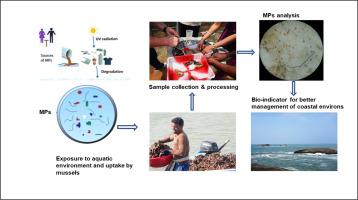Marine Pollution Bulletin ( IF 5.8 ) Pub Date : 2021-07-06 , DOI: 10.1016/j.marpolbul.2021.112678 Jamila Patterson 1 , K Immaculate Jeyasanta 1 , R L Laju 1 , J K Patterson Edward 1

|
This study investigated the microplastic (MPs) contamination of the mussels, P. viridis and P. perna of different sizes, and their environment viz. water and sediment. MPs were recovered from the soft tissues of both species. The mean abundance of MPs ranges from 0.87 ± 0.55 to 10.02 ± 4.15 items/individual; 0.1 ± 0.03 to 2.05 ± 0.33 items/g; 31.57 ± 7.63 to 59.25 ± 14.32 items/l in water, and 79.54 ± 18.66 to 108 ± 40.36 items/kg in sediment. Smaller mussels (3–6 cm) are capable of ingesting higher quantities of MPs per gram of tissue weight, and the rate of MP uptake decreases when the mussels grow in size. These might be due to the faster filtration rate in smaller mussels. MPs of fiber type and blue color in the size range of 500 μm to 1 mm are predominant in mussels. Eleven different polymeric groups were identified, of which PE is the most common, followed by PP. The distribution patterns of MP abundance, shape, size, color, and polymer in mussels more closely resemble those in water. There is no significant difference in MP quantities between P. perna and P. viridis (p > 0.05). FTIR-ATR spectroscopy and SEM analysis show that most of the MPs have been strongly weathered. EDAX analysis detects heavy metals like As, Ni, Fe, Zn, and Cd associated with MPs. This study shows that the MPs contents of both the mussel species are transferred from seawater to their edible meat. This study again proved that mussels can act as bio indicator of MPs pollution.
中文翻译:

印度食用贻贝(Perna perna 和 Perna viridis)及其周围环境中的微塑料污染
本研究调查了贻贝、绿贻贝和珍珠贝的微塑料 (MPs) 污染不同大小,以及它们的环境即。水和沉积物。从两个物种的软组织中回收到 MP。MPs 的平均丰度范围从 0.87 ± 0.55 到 10.02 ± 4.15 个项目/个人;0.1±0.03~2.05±0.33个/g;水中 31.57 ± 7.63 至 59.25 ± 14.32 件/升,沉积物中 79.54 ± 18.66 至 108 ± 40.36 件/公斤。较小的贻贝(3-6 厘米)每克组织重量能够摄取更多的 MP,并且当贻贝变大时 MP 的摄取率会降低。这可能是由于较小的贻贝的过滤速度更快。500 μm 至 1 mm 大小范围内的纤维类型和蓝色 MP 在贻贝中占主导地位。确定了 11 个不同的聚合物基团,其中 PE 是最常见的,其次是 PP。MP 丰度、形状、大小、颜色、贻贝中的聚合物更接近水中的聚合物。MP数量之间没有显着差异P. perna和P. viridis ( p > 0.05)。FTIR-ATR 光谱和 SEM 分析表明,大多数 MPs 已经强烈风化。EDAX 分析可检测与 MP 相关的重金属,如 As、Ni、Fe、Zn 和 Cd。这项研究表明,这两种贻贝物种的 MPs 含量都从海水转移到可食用的肉中。这项研究再次证明贻贝可以作为 MP 污染的生物指示剂。



























 京公网安备 11010802027423号
京公网安备 11010802027423号